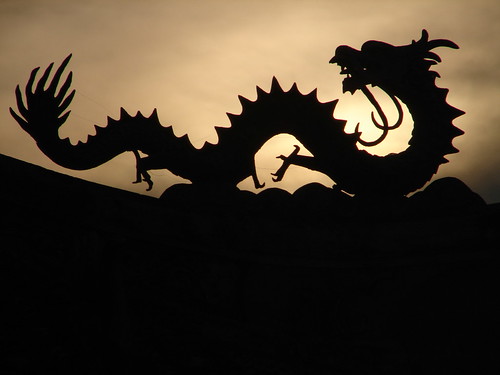
(Photo by ~zymon~)
According to the Chinese zodiac, it's now the Year of the Dragon, and I thought I'd do a special post on some of their real-life counterparts. No, dragons don't really exist, but there are a number of lizard species commonly known as 'dragons'.
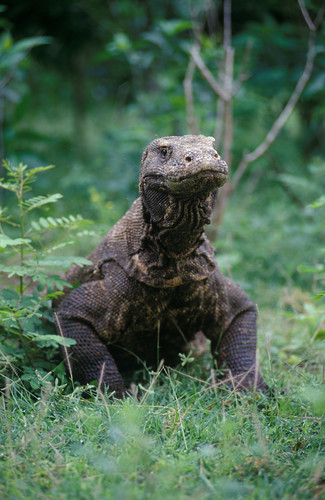
(Photo by mlp55)
The most famous 'dragon' is of course, the largest extant lizard, the Komodo dragon (Varanus komodoensis). With its fearsome, prehistoric appearance, one can easily imagine how early sightings of large monitor lizards may have led to stories about ferocious gigantic reptiles.
Besides the monitor lizards, however, there is a family of lizards which contains some very bizarre-looking members, known collectively as the agamids (F. Agamidae). Often adorned with frills and crests, some agamids look so strange that they would probably not appear out of place in a medieval bestiary.
The agamas are lizards found in various habitats throughout Africa, southern Europe, most of Asia, and all the way to Australia. There is a wide range of shapes and sizes, from small arboreal insectivores of the rainforests, to large burrowing vegetarians in the desert.
A number of species are found in Singapore, but this post will focus on a selection of some notable species from elsewhere:
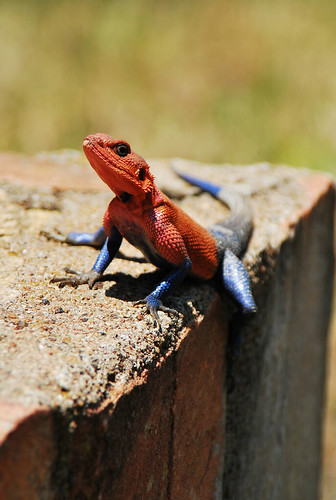
The common agama (Agama agama) is typically found in rocky areas in much of sub-Saharan Africa. The bright blue and red colours displayed by males during the breeding season have earned this the nickname of 'Spiderman lizard';
(Photo by mayor_of_clutch0625)
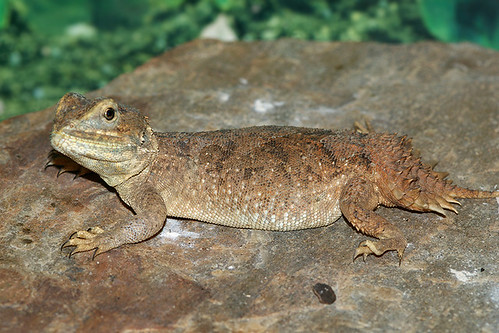
The dwarf shield-tailed agama (Xenagama taylori) inhabits arid regions of Ethiopia and Somalia. Digging tunnels to hide in, this lizard uses its stumpy yet spiky tail to block the entrance to the burrow, deterring potential predators;
(Photo by henk.wallays)

The Egyptian mastigure (Uromastyx aegyptia), also known as the Egyptian dabb or Egyptian spiny-tailed lizard, is primarily herbivorous, and lives in the deserts of Egypt, Libya, and the Middle East;
(Photo by CULTNAT)
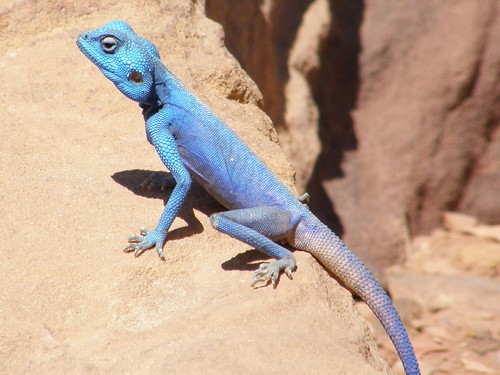
The Sinai blue agama (Pseudotrapelus sinaitus), another desert-dweller from Ethiopia and Egypt to the Arabian Peninsula, must be one of the most striking lizards of all, with males turning a bright blue during the breeding season;
(Photo by copepodo)

The secret toad-head agama (Phrynocephalus mystaceus), found in the deserts and semi-arid regions of Iran, Afghanistan, and Kazakhstan has a strange way of defending itself. When threatened, it opens its mouth and bares its teeth, common lizard behaviour, except for the bright reddish skin flaps in the corners of its mouth that flare open as well. This serves to make it look more intimidating;
(Photo by Ahmad Karimi)

Such threat displays are taken to the extreme by another agamid, the frilled lizard (Chlamydosaurus kingi) of the tropical savannah woodlands of Australia and southern New Guinea. The frill is ordinarily flattened and hangs loosely around the neck, but when threatened, this lizard, by opening its frill, hissing loudly, and even lunging, puts up an impressive show. Should the predator remain undaunted, the frilled lizard can make a swift getaway, running away on its hind legs;
(Photo by AusBatPerson)
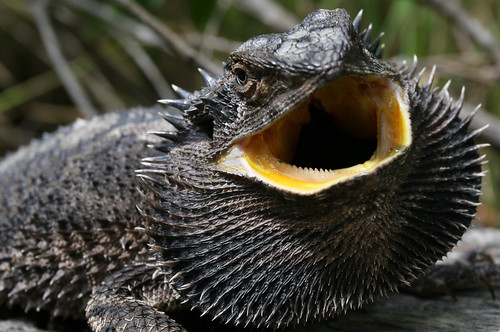
The bearded dragons, represented here by the eastern bearded dragon (Pogona barbata), are also found in Australia, and live in rocky semi-deserts and open woodlands. The spiny scales on the throat, and all over much of the body, can be erected when the lizard feels threatened, making it a prickly mouthful for any predator. Bearded dragons are highly popular as pets, and a number of interesting colour varieties have been selectively bred;
(Photo by maasha)
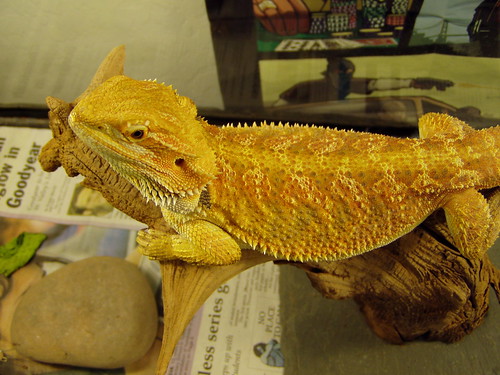
Captive-bred colour morph of central bearded dragon (Pogona vitticeps);
(Photo by jLablitz)
As an amusing aside, a video clip of a pet bearded dragon playing a game called Ant Smasher on its owner's smartphone recently became an online viral hit.
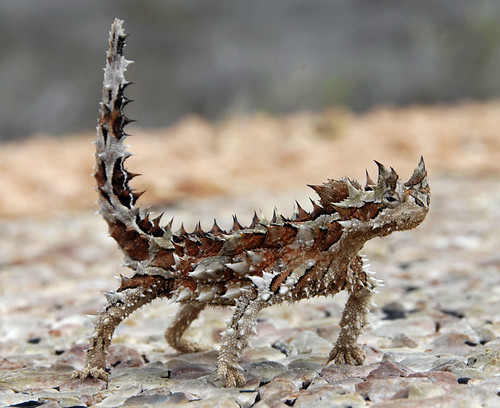
Australia has plenty of weird lizards, but the thorny devil (Moloch horridus) is surely one of the weirdest. The spines that cover this lizard not only provide defence against predators, and probably against the ants that it feeds on, but also enable it to drink while living in one of the driest habitats on the planet. As dew condenses on the spines at night, the water flows down into tiny grooves in the skin that eventually lead towards the mouth;
(Photo by pojic)
At the other extreme, there are agamids found living in wet, swampy habitats.

The Philippine sailfin dragon (Hydrosaurus pustulatus) is among the largest of the agamids, with large males reaching up to 1.2 metres in length. Omnivores that feed on insects as well as vegetable matter like fruits and leaves, the sailfin dragons can be thought of as the Southeast Asian equivalent of the green iguana (Iguana iguana), living in swamps and along rivers, seeking safety from predators by plunging or dashing into the water;
(Photo by woosang)
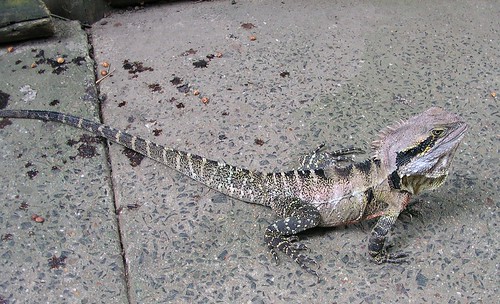
(Photo by brewbooks)
A similar lifestyle is seen in the somewhat smaller water dragons, of which there are 2 species, the Australian water dragon (Physignathus lesueurii) of eastern Australia (above), and the Chinese water dragon (Physignathus cocincinus) of southern China and Indochina (below);
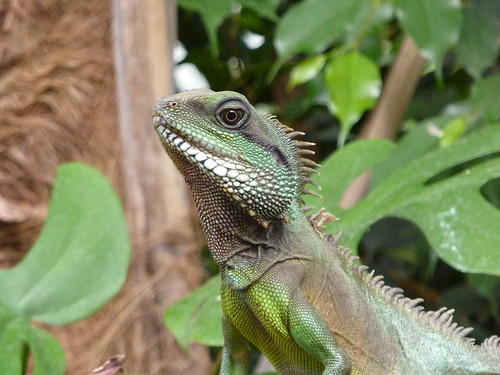
(Photo by ♫ Claire ♫)
The forests and woodlands of tropical Asia are home to a wide variety of agamids, some of which also possess strange anatomical features.
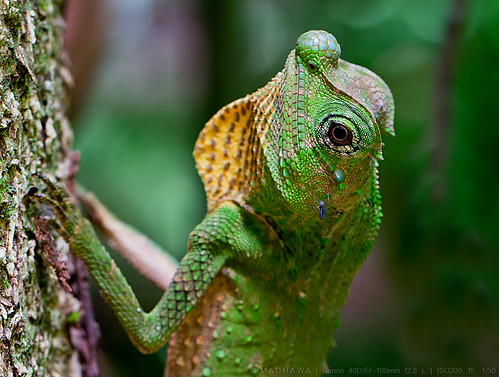
In the forests of Sri Lanka lives the hump-nosed lizard (Lyriocephalus scutatus);
(Photo by Madhawa)
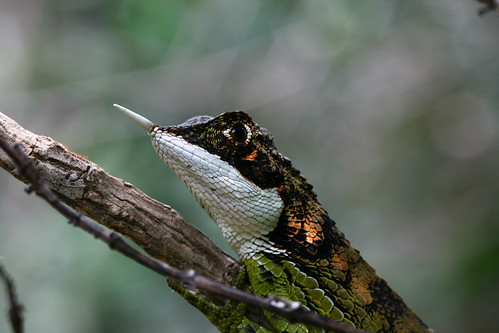
The rhinoceros-horned lizard (Ceratophora stoddartii) is also endemic to forests in Sri Lanka, and males have this strange horn on their noses, which is actually an outgrowth of the scale at the tip of the nose. Males in other members of the genus have nasal growths that look more like leaves or pine cones;
(Photo by cheranga.d)

Tennent's leaf-nosed lizard (Ceratophora tennentii);
(Photo by Ruchira Somaweera, from ARKive)

Rough nose-horned lizard (Ceratophora aspera);
(Photo by Dr. Peter Janzen, from CalPhotos)

The Sumatran nose-horned lizard (Harpesaurus beccarii) not only has a pair of horns on the tip of its snout, but also has large triangular scales running down its back. Another species, the Bornean nose-horned lizard (Harpesaurus borneensis), is unique in being one of the few agamid species known to give birth to its young instead of laying eggs, though the reproductive habits of many agamids are currently unknown;
(Photo by Ulrich Manthey, from The Reptile Database)

Much of the strange ornamentation found in agamids exists not to fend off predators, but plays a critical role in sexual selection. In the hump-nosed lizard, rhinoceros-horned lizard, and Sumatran nose-horned lizard, the nasal growths are more pronounced in adult males. Similarly, in the fan-throated lizard (Sitana ponticeriana) from Sri Lanka and India, it is the males that develop a prominent and brightly-coloured dewlap, which is used to attract females and intimidate rival males;
(Photo by Harsha Matarage)
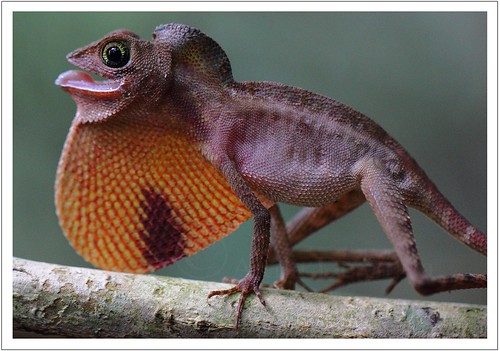
The brown-patched kangaroo lizard (Otocryptis wiegmanni), another Sri Lankan endemic, possesses a similar feature;
(Photo by Akila De Silva)
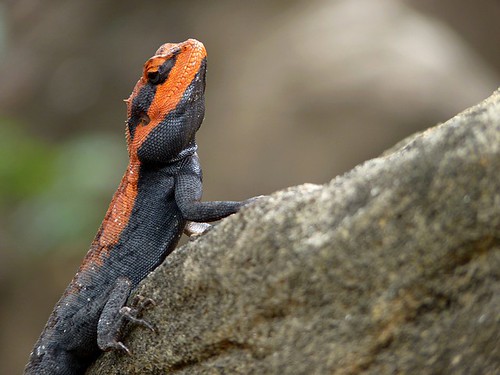
The drive to attract a mate is so strong that it seems that many agamids, such as this male Blanford's rock agama (Psammophilus blanfordanus) from southern India, make sure that they're visible to all, regardless of the risk of being spotted by predators;
(Photo by Ishan K)
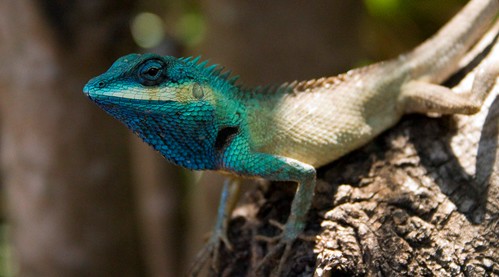
The males of the blue crested lizard (Calotes mystaceus) of Indochina are similarly brightly coloured;
(Photo by Mark Bakkers)

The horned tree lizard (Acanthosaura armata) of southern Thailand, Peninsular Malaysia, and Sumatra, also possesses horns, though these grow from above the eyes;
(Photo by hisno)
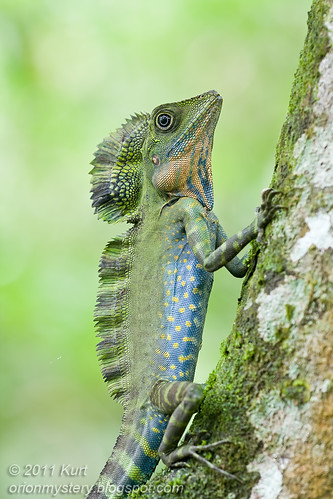
Another agamid from forests in surrounding countries, the great anglehead (Gonocephalus grandis) of the Malay Peninsula, Sumatra, and Borneo, has a large comb-like crest of spines;
(Photo by Kurt (orionmystery.blogspot.com))
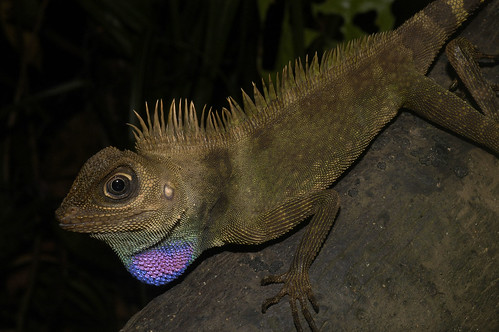
Its close relative, the Bell's anglehead (Gonocephalus belli), of the Malay Peninsula and Borneo, may lack the pronounced crests, but it still has the impressive spines and the brightly-coloured dewlap;
(Photo by FunkyHumanBeing)
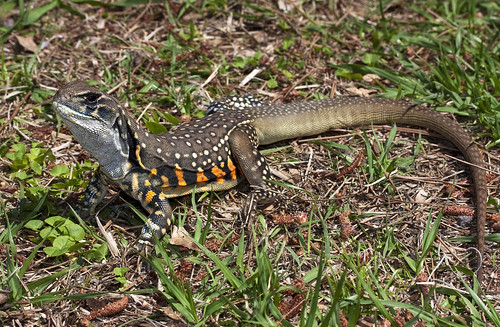
The common butterfly lizard (Leiolepis belliana) is a member of a small group of agamids found in open habitats in Southeast Asia. What's interesting is that out of 8 known species of butterfly lizards, 4 are parthenogenetic, meaning that all individuals in these species are female, with all offspring being clones of their mother. They are hunted as food in some regions - the most recently described species was first discovered in a Vietnamese restaurant;
(Photo by Cat Smith)
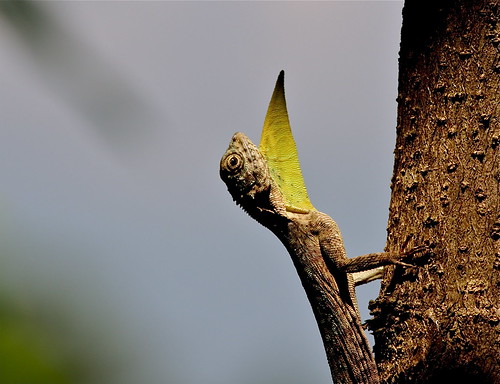
The forests of southwest India and Southeast Asia, all the way to the islands of the Malukus, the Philippines, and Timor, are home to a widespread and successful group of agamids. The flying dragons, represented here by the Javan flying dragon (Draco volans), are perhaps among the most unique of the agamids, for they alone have managed to take to the air. I've already written more about flying dragons in a recent post.
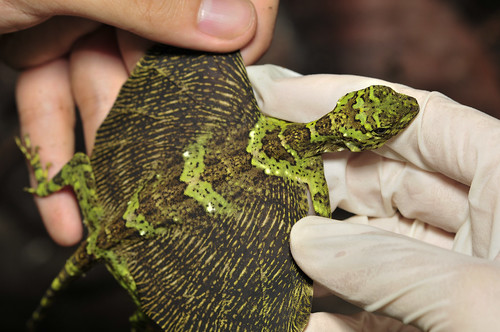
Great gliding lizard (Draco maximus);
(Photo by Steven Wong (ATKR))
Many agamids are capable of changing colour, depending on their surroundings and their mood, and are sometimes called chameleons, although this is inaccurate and misleading. Chameleons (F. Chamaeleonidae) are a closely related but nonetheless entirely separate family of lizards, and the only chameleons found in Asia live in parts of the Middle East, India, and Sri Lanka, while their stronghold is in Africa and Madagascar. Interestingly enough, a number of toad-head agamas use their tongues to feed in a manner that is very similar to that seen in chameleons, which raises a lot of questions as to how widespread the supposedly unique chameleon tongue might actually be among the agamids.

Indian chameleon (Chamaeleo zeylanicus);
(Photo by lalie sorbet)
The agamids and chameleons are closely related, and together with the iguanas (F. Iguanidae) and related families, make up a group known as the Iguania. The distribution of the agamids almost mirrors that of the iguanas, which replace the agamids in equivalent habitats in the Americas, and also come in all sorts of shapes and sizes.
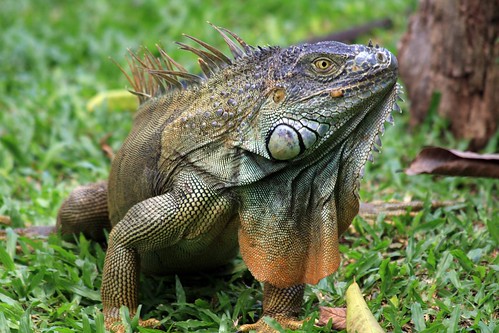
Green iguana;
(Photo by nachocorreanet)
Many of the iguana species living in tropical Central and South America, as well as the islands of the Caribbean, are similar to the agamids, in that they carry bizarre headgear or are brightly coloured.
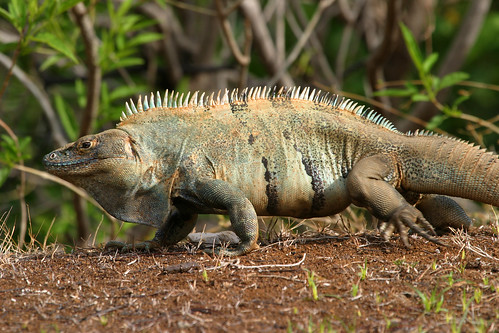
Black spiny-tailed iguana (Ctenosaura similis);
(Photo by bayucca)

Galapagos marine iguana (Amblyrhynchus cristatus);
(Photo by geoff-e)
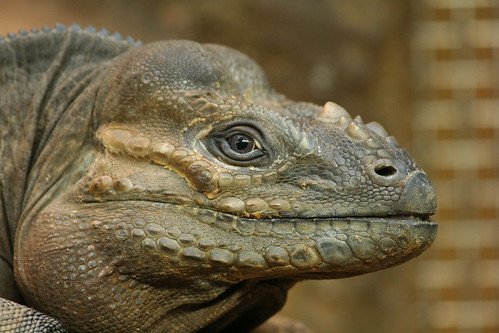
Rhinoceros iguana (Cyclurus cornuta);
(Photo by Dries Arnolds)
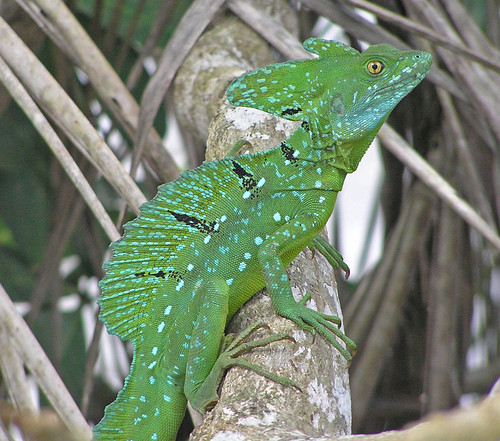
Plumed basilisk (Basiliscus plumifrons);
(Photo by slider5)

Helmeted iguana (Corytophanes cristatus);
(Photo by Hernan Arias)

Brown anole (Anolis sagrei);
(Photo by antiundersteer)
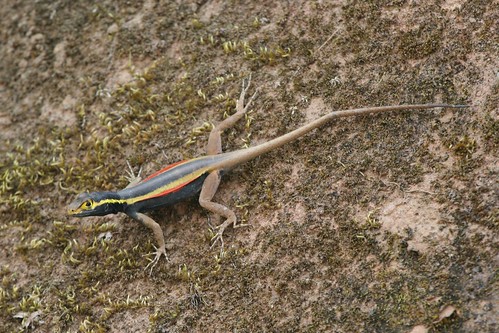
Black lava lizard (Tropidurus melanopleurus);
(Photo by Arthur Chapman)
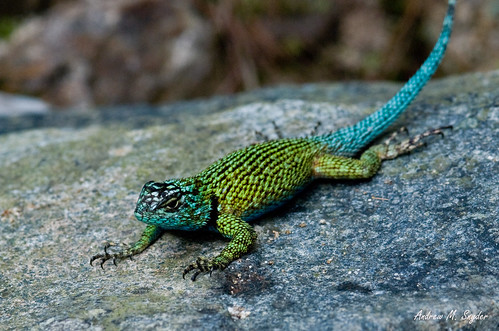
Emerald swift (Sceloporus schmidti);
(Photo by asnyder5)

Texas horned lizard (Phrynosoma cornutum);
(Photo by Jack Goldfarb)
It's impossible to look at the horned lizards of the deserts and grasslands of North America and not be reminded of the thorny devil. Though they are only distantly related, the similarities between the thorny devil and horned lizards could be seen as an example of convergent evolution.
Strangely enough, in a quirk of biogeography, despite the close proximity of the islands of Fiji and Tonga to Australia and New Guinea, these islands are the domain of iguanas, not agamids.
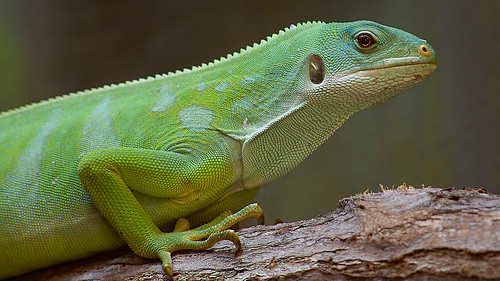
Fiji banded iguana (Brachylophus fasciatus);
(Photo by Leszek.Leszczynski)
Similarly, although Madagascar is off the coast of Africa, it is an endemic family of iguanas (F. Opluridae) that inhabits this island, instead of agamids.
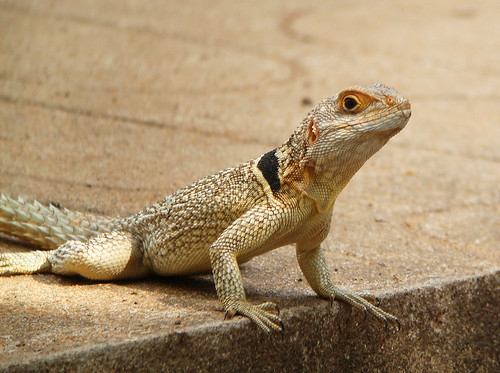
Madagascar collared iguana (Oplurus cuvieri);
(Photo by Diana B.)
I'm tempted to look at the diversity of iguanas as well, but that will have to come another time. Next up, a look at the agamid lizards found in Singapore.